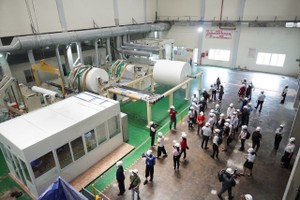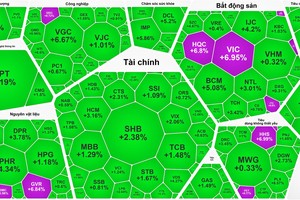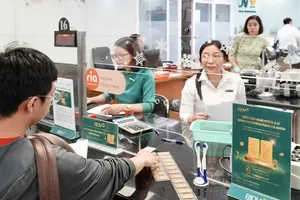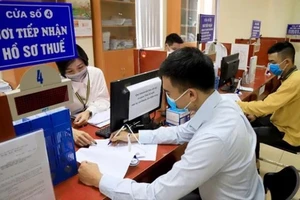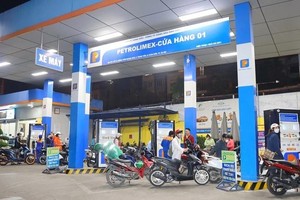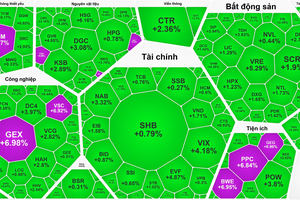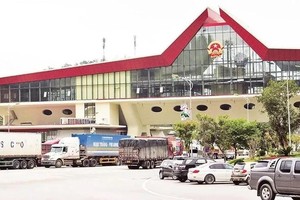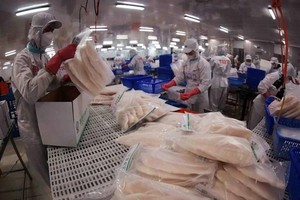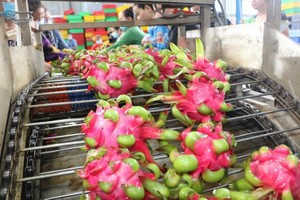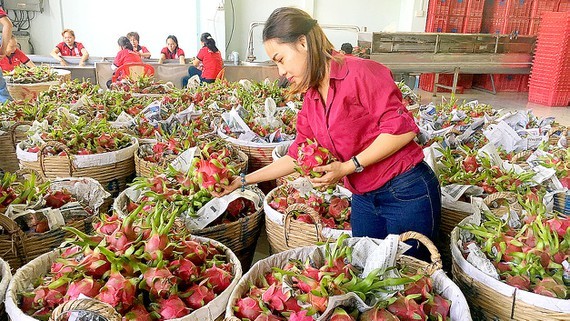
Export market of Vietnamese vegetables and fruits still have lots of potentials, especially some countries are having low proportion. For Vietnamese products to meet regulations of import countries, Vietnamese enterprises need to connect with local enterprises to stabilize and comply with market regulations.
According to the Ministry of Industry and Trade, Vietnamese vegetables and fruits have been exported to 55 countries and territories. Currently, total capacity of global vegetables and fruits market is at around US$240 billion annually. In the past years, vegetables and fruits sector is one of the steady and fast-growing sectors of Vietnamese agriculture with a growth of 26 percent per annum.
Last year, vegetables and fruits exports reached $3.8 billion, an increase of 8.8 percent in comparison with the previous year. The vegetables and fruits sector has surpassed rice, black pepper and tea to become one of the key agricultural products of Vietnam, creating new motivation for agricultural development.
This is proved by increases of markets. The Northeast Asian market reached $219 million in 2018, accounting for 5.5 percent, and $185 million in the first nine months of this year, accounting for 6.5 percent. The EU and US markets touched $256 million last year, accounting for 6.7 percent, and $271 million in the first nine months of this year, accounting for 9.6 percent. especially, the Asian market accounted for more than 80 percent of total export turnover.
Of which, China’s market hit $2.8 billion last year, accounting for 74 percent, and more than $2 billion in the first nine months of this year, accounting for 71 percent, leading in import of vegetables and fruits, followed by South Korea with $113 million, accounting for 2.99 percent, Japan with $105 million, accounting for 2.76 percent, the ASEAN with $134.2 million, accounting for 3.52 percent, and Taiwan (China) with $41.5 million, accounting for 1.1 percent.
Enterprises have taken advantage of large export rooms of neighboring countries, such as China, South Korea, Japan and Singapore, thanks to favorable conditions of location, similar habits and legal framework of completed free trade agreements. According to the Asia-Africa Market Department under the Ministry of Industry and Trade, China is a near market with the huge purchasing power of 1.4 billion people. The average vegetables and fruits export growth was 60 percent and Vietnam’s vegetables and fruits export turnover accounted for 73 percent of agricultural product exports. Japan is the fourth-largest agricultural product importer in the world with import turnover always above $50 billion. Vegetable imports reached $34 million, of which, the proportion of imports from Vietnam accounted for 1.3 percent; fruits imports were at around $36 million, of which, the proportion of imports from Vietnam accounted for 1.1 percent.
According to the Agricultural Product Processing and Market Development Department under the Ministry of Agriculture and Rural Development, at the present, Vietnam has more opportunities when participating in free trade agreements and investment protection agreements with commitments of tariff-rate quota and tariff reduction for Vietnamese agro-forestry-aquatic products, including fragrant rice with quota of 80,000 tons, broken rice with no quota, cassava starch with quota of 25,000 tons, sweet corn with quota of 5,000 tons, baby corn with no quota, garlic with quota of 400 tons, mushroom with quota of 350 tons and other kinds of vegetables and fruits with no quota.
Two important issues relating to export vegetables and fruits are microbial contamination and chemical and pesticide residues. From the perspective of production management, Mr. Le Thanh Hoa, deputy head of the Agricultural Product Processing and Market Development Department, suggested that enterprises need to cooperate with farmers to ensure supply and training to improve the ability of human resources.
At the same time, enterprises need to change their awareness of food safety management and supervision, from checking the final products to supervising hazards in the entire production chain. To have accurate market information, enterprises need to build an information exchange channel on market regulations between regulatory agencies and importers.
Currently, enterprises have not fully understood the market or had a long-term plan while the quality of their products is still poor so their competitiveness is weak. The State needs to increase the dissemination of market information, support for trade promotion and trade connection activities for enterprises to produce and cultivate in accordance with standards.
In order to export successfully, vegetables and fruits need to ‘win’ in the domestic market. Because, at the present, food safety has not been ensured. There are many criteria in agricultural production in Vietnam while developed countries have only one safety criterion to manage easily. In addition, if post-harvest technology remains poor, Vietnamese products will not be able to compete with those of other countries.
According to the Ministry of Industry and Trade, Vietnamese vegetables and fruits have been exported to 55 countries and territories. Currently, total capacity of global vegetables and fruits market is at around US$240 billion annually. In the past years, vegetables and fruits sector is one of the steady and fast-growing sectors of Vietnamese agriculture with a growth of 26 percent per annum.
Last year, vegetables and fruits exports reached $3.8 billion, an increase of 8.8 percent in comparison with the previous year. The vegetables and fruits sector has surpassed rice, black pepper and tea to become one of the key agricultural products of Vietnam, creating new motivation for agricultural development.
This is proved by increases of markets. The Northeast Asian market reached $219 million in 2018, accounting for 5.5 percent, and $185 million in the first nine months of this year, accounting for 6.5 percent. The EU and US markets touched $256 million last year, accounting for 6.7 percent, and $271 million in the first nine months of this year, accounting for 9.6 percent. especially, the Asian market accounted for more than 80 percent of total export turnover.
Of which, China’s market hit $2.8 billion last year, accounting for 74 percent, and more than $2 billion in the first nine months of this year, accounting for 71 percent, leading in import of vegetables and fruits, followed by South Korea with $113 million, accounting for 2.99 percent, Japan with $105 million, accounting for 2.76 percent, the ASEAN with $134.2 million, accounting for 3.52 percent, and Taiwan (China) with $41.5 million, accounting for 1.1 percent.
Enterprises have taken advantage of large export rooms of neighboring countries, such as China, South Korea, Japan and Singapore, thanks to favorable conditions of location, similar habits and legal framework of completed free trade agreements. According to the Asia-Africa Market Department under the Ministry of Industry and Trade, China is a near market with the huge purchasing power of 1.4 billion people. The average vegetables and fruits export growth was 60 percent and Vietnam’s vegetables and fruits export turnover accounted for 73 percent of agricultural product exports. Japan is the fourth-largest agricultural product importer in the world with import turnover always above $50 billion. Vegetable imports reached $34 million, of which, the proportion of imports from Vietnam accounted for 1.3 percent; fruits imports were at around $36 million, of which, the proportion of imports from Vietnam accounted for 1.1 percent.
According to the Agricultural Product Processing and Market Development Department under the Ministry of Agriculture and Rural Development, at the present, Vietnam has more opportunities when participating in free trade agreements and investment protection agreements with commitments of tariff-rate quota and tariff reduction for Vietnamese agro-forestry-aquatic products, including fragrant rice with quota of 80,000 tons, broken rice with no quota, cassava starch with quota of 25,000 tons, sweet corn with quota of 5,000 tons, baby corn with no quota, garlic with quota of 400 tons, mushroom with quota of 350 tons and other kinds of vegetables and fruits with no quota.
Two important issues relating to export vegetables and fruits are microbial contamination and chemical and pesticide residues. From the perspective of production management, Mr. Le Thanh Hoa, deputy head of the Agricultural Product Processing and Market Development Department, suggested that enterprises need to cooperate with farmers to ensure supply and training to improve the ability of human resources.
At the same time, enterprises need to change their awareness of food safety management and supervision, from checking the final products to supervising hazards in the entire production chain. To have accurate market information, enterprises need to build an information exchange channel on market regulations between regulatory agencies and importers.
Currently, enterprises have not fully understood the market or had a long-term plan while the quality of their products is still poor so their competitiveness is weak. The State needs to increase the dissemination of market information, support for trade promotion and trade connection activities for enterprises to produce and cultivate in accordance with standards.
In order to export successfully, vegetables and fruits need to ‘win’ in the domestic market. Because, at the present, food safety has not been ensured. There are many criteria in agricultural production in Vietnam while developed countries have only one safety criterion to manage easily. In addition, if post-harvest technology remains poor, Vietnamese products will not be able to compete with those of other countries.
